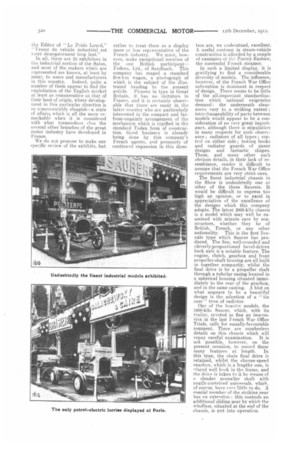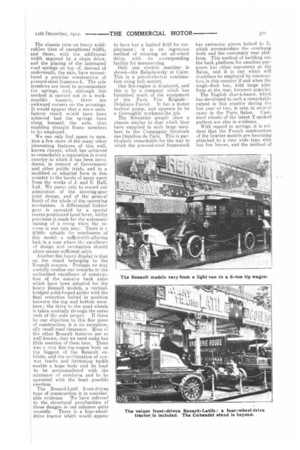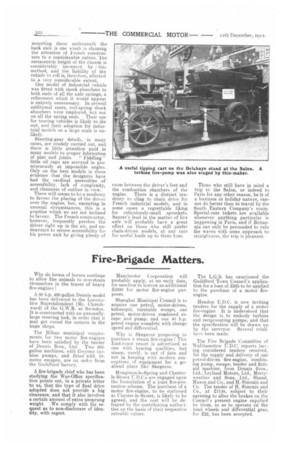At this end of the year—a year which is setting
Page 7

Page 8

Page 9

Page 10

If you've noticed an error in this article please click here to report it so we can fix it.
up records for business pressure in so many branches of industry, and a year, too, which has achieved notoriety for treacherous climatic vagaries, we do not suppose that. any great number of our readers will be tempted to cross the Channel, with a visit to the Thirteenth Exposition Internationale de L'Automobile as the principal object.
It is always instructive, however, to keep an observant eye upon the changes which are being made in other countries in regard to construction, al, indeed, to methods of operation. France, of course, bad, until recent years, made more rapid progress in connection with all branches of automobilism than any other .country. Its pre-eminent position in that respect, however, is no longer maintained, and an examination of the commercial models which are, at the time of writing, on exhibition at this year's Salon conveys the impression that. the industry in which we are particularly interested has advanced a great deal further in this country than it has across the Channel.
We propose briefly to consider the principal constructional characteristics which belong to essentiallyFrench models, and perhaps to draw comparisons in those respects with modern English methods. The heavy-vehicle section of the Salon, situated at one end of the principal hall of the Grand Palais, is a disappointing one ; it is effectively swamped by the vast preponderance of touring-car exhibits and their multitudinous accessories.
During a visit by a member of the staff of this journal, it was observed that the industrial side of the Show appeared to attract but very little attention from the ordinary visitor, and that, perhaps, is the attitude of the French people generally with regard to the industrial vehicle. The purely utilitarian uses of the commercial model makes but little appeal to the imagination of the ordinary Frenchman. It is true, of course, that goods delivery and passenger transport are being increasingly maintained by means of motor vehicles in all parts of France, but the progress is slow, and, in the words of our esteemed colleague, the Editor of " Le Poids Louid," " lessor du vehicle industriel est reste desesperement trop lent."
In all, there are 23 exhibitors in the industrial section of the Salon, and most of the makers which are lepresented are known, at least by name, to users and manufacturers in this country. Indeed, quite a number of them appear to find the exploitation of the English market at least as remunerative as that of their land of origin, where development in this particular direction is so unaccountably sluggish—a state of affair which is all the more remarkable when it is considered with what tremendous Ofin the several other branches of the great motor industry have developed in France.
We do not pronose to make any specific review of the exhibits, but rather to treat them as a display more or less representative of the French industry. We must, however, make exceptional mention of the one British participantFodens, Ltd., of Sandbach. This company has staged a standard five-ton wagon, a photograph of which is the subject. of the illustrated heading to the present article. Pioneer in type in Great Britain, it has no imitators in France, and it is certainly observable that there are many in the latter country who are particularly interested in the compact and farfrom-ungainly arrangement of the mechanism which is typified in the standard Foden form of construction. Good business is already being done by this company's French agents, and prospects of continued expansion in this three tion are, we understand, excellent. A useful contrast in steam-vehicle construction is afforded by a couple of examples ot thc Purrey-Exshaw, the successful French steamer.. In such a limited display, it is gratifying to find a considerable divelsity of models. The influence, however, of the French War Office subvention is dominant in respect of design. There seems to be little of the all-important standardization which national exigencies demand : the underneath clearances vary to a striking extent : interchangeability of parts between models would appear to be a consideration of no very Feat importance, although there is stipulation in many respects for such observance ; radiators of all types ; control on either side ; towing hooks and radiator guards of queer designs and fantastic shapes. These, and many other such obvious details, in their lack of resemblance, render it difficult to assume that the French War Office requirements are very strict ones.
The finest. industrial chassis in the Show is undoubtedly one or other of the three Sewers. It would be difficult to express too high an opinion, or to excel in appreciation of the excellence of the designs which this company adopts. The latest 2000-kilo chassis is a model which may well be examined with minute care by constructors, whether they be of British, French, or any other
nationality. This is the first liveaxle type which Saurer has produced. The fine, well-rounded and cleverly-proportioned bevel-driven back axle is a notable feature. The engine, clutch, gearbox and front nropeller-shaft housing are all built in together compactly, whilst the final drive is by a propeller shaft through a tubular easing located in a spherical housing situated immediately to the rear of the gearbox. and in the same casting. A blot on what anpears to be a beautiful design is the adontion of a "tin ease " tyne of radiator.
One of the h.eavier models, the 5000-kilo Saurer, which, with its trailer, created so fine an impression in the last French War Office Trials, calls for equally-favourable comment. There are numberless details on this chassis which will repay careful examination. It is not possible, however, on the present occasion, to record these many features at length. In this type, the chain final drive is retained, whilst the change-speed gearbox. which is a lengthy one, is ',laced well back in the frame, and the (hive is taken to it by means of slender propeller shaft with neatly-contrived universals, which. Of C011v:,1e, have very little to do. A snecial member of the striking gear has an extension ; this controls an additional sliding gear by which the windlass, situated at the end of the chassis, is put into operation.
The chassis runs on heavy solidrubber tires of exceptional width,
and these, with the additional
width imposed by a chain drive, and the placing of the laminated road springs on top of, instead of underneath, the axle, have necessitated a peculiar construction of pressed-steel framewm k. The side members are inset to accommodate the springs, and, although this
method is carried out in a work
manlike manner, there are awkward corners on the pressings. It would appear that a moie satis factory result would have been achieved had the springs been slung beneath the axle, thus enabling straight frame members to be employed.
We can only find space. to mention a few more of the many other
interesting features of this well known chassis, which has achieved so remarkable a eeputation in every country to which it has been intro duced, in respect of Government and other public trials, and in a modified or adapted form in this
country in the hands of many users from the works of J. and E. Hall, Ltd. We pause only to record our admiration of the steering-gear joint design, and of the geneial finish of the whole of the operating mechanism. A differential lucking gear is onerated by a special centre-positioned hand lever, whilst provision is made for the automatic raising of a snrag when the reverse is nut into gear. There is e 9700fr. subsidy for purchasers of this model-a sufficientiv-alluring bait in a case where the excellence of design and mechanism should alone secure sufficient sales.
Another fine heavy display is that on the stand belonging to the Renault concern. Perhaps we may usefully confine our remarks to the undoubted excellence of construction of the massive back axles which have been adopted for the heavy Renault models, a verticalbridged solid-forged girder with the final reduction bolted in position between the top and bottom members; the drive to the road wheels is taken centrally through the outer ends of the axle proper. If there be one objection to this fine piece of construction, it is its exceptionally small mad clearance. Most of the other Renault features are so well known, that we need make but little mention of them here. There was a very fine tip-wagon body on the biggest. of the Renault exhibits, and the combination of runway tracks and lightening tackle enable a huge body and its load to be accommodated with the minimum of overhang and to be operated with the least possible exertion.
The Renard-Latil front-driven type of construction is in considerable evidence. We have referred to the structural peculiarities of these designs in our columns Quite
recently. There is a four-wheeldrive tractor which would appear
to have but a limited field for employment: it is an ingenious method of securing an all-wheel drive, with its corresponding facility for manceuvring. Only one electric machine is shown—the Balachowsky et Cain.
This is a petrol-eleettic combinetion using hub motors.
One fire-engine is displayed, and this is by a company which has furnished much of the equipment of the Paris Fire Brigade—. Detahaye-Fareot. It has a motor turbine pump, and appears to be a thoroughly workmanlike job. The Schneider people show a chassis similar to that which they have supplied in such large numbers to the Compagnie Geinerale des Omnibus de Paris. This is particularly remarkable for the way in which the pressed-steel framework has extension pieces bolted to it, which accommodate the overhung body and the customary rear platform. This method of building out the back platform for omnibus purposes has other exponents at the Salon, and it is one which will doubtless be employed by constructors in this country if and when the single-deck bus, with large platform_ at the rear, becomes popular. The English char-it-banes, which has developed to such a remarkable extent in this country during the last year or two, is seen in several.
cases in the Paris Salon. Caststeel wheels of the latest Y-spoked pattern are also in evidence.
With regard to springs, it is evident that the French constructors of the heavier models are becoming attached to a very wide type with but few leaves, and the method of mounting these underneath the back axle is one which is claiming the attention of French constructors to a considerable extent. The metacentrie height of the chassis is considerably increased by • this method, and the liability of the vehicle to roll is, therefore, affected to a very considerable extent.
One model of industrial vehicle was fitted with shock absorbers to both ends of all the axle springs, a refinement which it would appear is entirelyunnecessary. In several additional cases, coil-spring shock absorbers were employed, but not on all the spring ends. Their use for touring vehicles is likely to die out, and their adoption for industrial models on a large scale is unlikely.
Steering-gear details, in many cases, are crudely carried out, and there is little attention paid in many models to proper lubrication of pins and joints. `` Fiddling" little oil caps are screwed in promiscuously at. impossible angles. Only on the best models is there evidence that the designers have had the cardinal necessities of accessibility, lack of complexity, and cleanness of outline in view.
There still seems to he a tendency to favour the placing of the driver over the engine, but, excepting in unusual circumstances, this is a practice which we are not inclined to favour. The French constiuctor, however, frequently perches the driver right up in the air, and endeavours to secure accessibility for his power unit by giving plenty of room between the driver's feet and thecombustion chambers of the
engine. There is a distinct 'tendency to cling to chain drive for French industrial models, and in some cases a regrettable liking for ridiculously-small sprockets. Saurer's lead in the matter of live axle will probably have a great effect on those who still prefer chain-driven models, at any rate for useful loads up to three tons. Those who still have in mind a trip to the Salon, or indeed to Paris for any other reason, be-it of a business or holiday nature, cannot do better than to travel by the south Eastern Company's route. Special-rate tickets are available whenever anything particular is happening in Paris, and if Britannia can only be persuaded to rule the waves with some approach to straightness, the trip is pleasant.
























